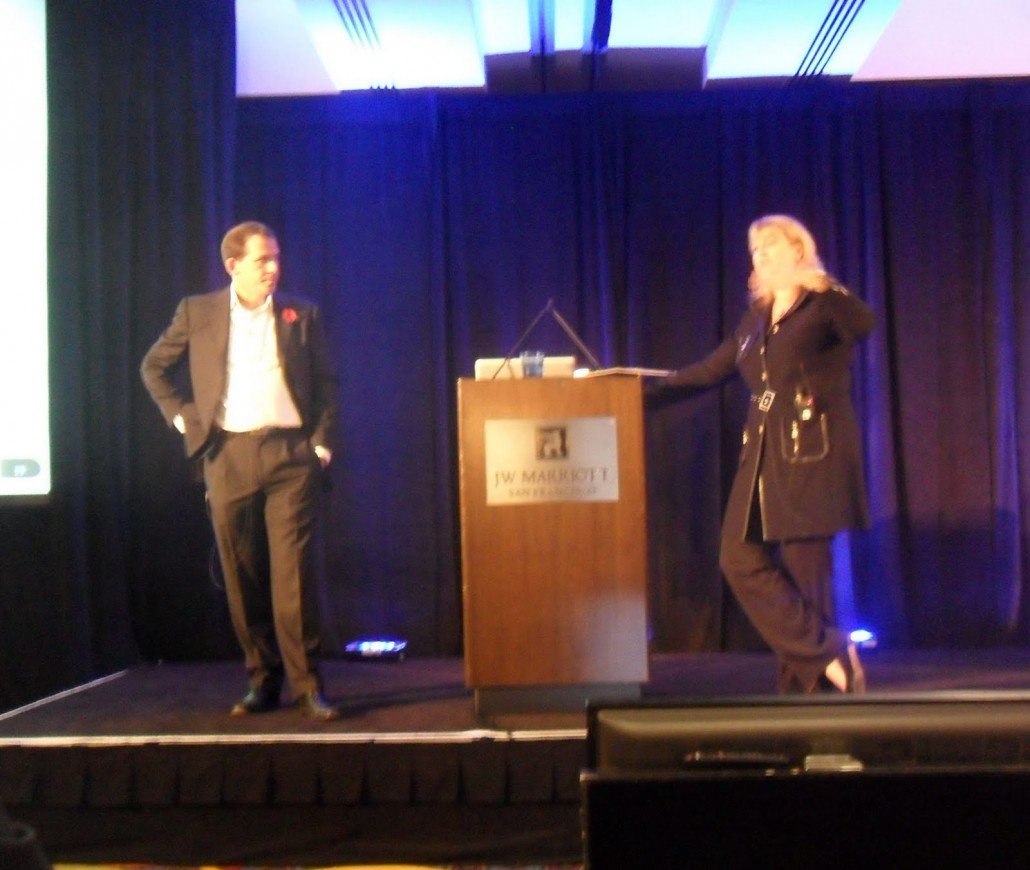
Interesting report from Good Technology was written up by Securities Technology Monitor today on the different rates of adoption of the iPad between different segments – and not surprisingly the financial services industry is way ahead.
Typically we have seen financial services be more conservative among our customers – especially when it comes to security and technology on the desktop (IE6 anyone? Ugh) but when it comes to facing the client the financial services industry has always been nimble at creating the most attractive image. Having your financial advisor, or your sales person, show up with an iPad has sex appeal and raises the client’s confidence that the advisor is on the leading edge. And the visual appeal of the iPad’s crisp, clear screen would make almost any performance charts just look better.
Good’s fourth quarter report shows that in the battle between iOS and Android tablets the iPad is taking share – activations climbed from 60% to 68%. Blackberry is not included in the study since Good’s value to their customer is adding Blackberry-like security to non-Blackberry devices. It will be interesting to see what changes, if anything, once RIMM has a competitive tablet.

Great article in Information Week today. Seth believes “Data integration will be a top story in information technology in 2011″ – and his view is based on the emergence of the “beyond-ETL” approach. (note ETL is broadly used in data analysis applications and means – extraction, transform, load).
FirstRain is one of the paths Seth discusses – in particular our approach to time-sequencing the web. He quotes Marty – “The application of semantic analysis that is ‘business structure aware’ is crucial to be able to identify and deliver relevant business information that is scattered throughout [disparate] sources,” says the company’s technology vice president, Marty Betz. Also crucial is the ability to synthesize time sequence from pages found on the open Web.
- and I love that even in a simple examples you can quickly see the time issues that show up with Google’s popularity based approach: “Time sequence is important! Indeed, the number-three result returned by a Google search for “us senator pennsylvania” was now-former Senator Arlen Specter’s now-disappeared Senate Web page.”
In contrast – we analyze the flow of content through our pipeline and so our system can dynamically model and adjust its understanding of the market ecosystems around companies and industries – to quote Dr Betz again.
Betz describes the use of trending and anomaly detection, applied to unstructured narrative content from a variety of sources, to enable a different class of questions to be systematically asked, analyzed and answered via answers that require “connecting the dots.”
So in FirstRain we have broad-but-selective content acquisition and integration, with the application of goal-relevant organizing principles, to respond to a high-value business need: timely access to corporate developments.
We definitely agree with Seth that data integration area is an area of significant investment across multiple companies over the next year – to advance ease-of-use and increase the level embedded use and end-user specific integration capabilities.

I’m reminded of something I learned a long time ago about relationship dynamics in the workplace – from the Zen master of leadership Renn Zaphiropoulos.
Teamwork is critical to moving fast. I wrote in the past how trust is simply more efficient. It allows people to share risky ideas, make decisions quickly-learn-change, and to be safe so they do so again and again. I have no respect for attacking behavior in the workplace – it’s immature and destructive and hurts the team. I’m frustrated sometimes in silicon valley with the cult of the technical jerk savant (ref The Social Network film – note the object of the cult is almost always a white male – and I guarantee they are not always white). The vast majority of hard working technical professionals are not like that and quality companies follow the No Asshole Rule (ref the book on Amazon) and don’t tolerate the behavior.
Attacking behavior often arises between people who have not developed a conscious relationship of mutual respect and so the relationship deteriorates to one of mutual contempt. This is because the Respect-Contempt imbalance is inherently unstable. It’s too caustic for the one held in contempt to sustain so survival skills require the relationship degrade into mutual contempt.
The leader’s role is to help each person see and learn to respect the strengths of the other, even if their role and contribution is very different. Everyone has a role to play and value to contribute or they would not be here. (It’s also important for us to try to weed out the bad behaviors during the interview process; looking for arrogance and disrespect for others being subtly communicated as the candidate reviews their history.)
The hardest role to be playing is the person who is being attacked by an intellectual bully in the team. I have seen this at the peer level, rarely see it down the power hierarchy these days in technology (good people simply leave) and see it surprisingly often up the power hierarchy. It’s easier to take cheap shots up at your management because they just have to take it – they should not attack back (although that’s a matter of style choice – I know one former CEO who would intentionally verbally obliterate disrespectful employees – but it’s not my style choice).
In all cases my advice to the person being attacked is take the high ground. It’s unlikely to be personal and it’s more likely to be about the other person and some threat they are feeling in the moment than it is about you. I was in a situation recently where this happened to me where I am a board member (it was a very difficult conversation with a member of management) and I worked hard to stay calm, listen, let the energy run it’s course, and then return to the problem at hand.
Respect builds over time, as does trust. And if you find yourself in a contempt-respect or contempt-contempt relationship ask for help. Your manager’s job is to help you with it.

From Aparna Gupta – Director of Analytics - Reporting from the first Grace Hopper Celebration of Women in Computing in India
While most of my team in California was at Dreamforce last week, I had the pleasure of being a part of the Grace Hopper conference at India’s own silicon valley- Bangalore, in which FirstRain was a scholarship sponsor this year. I have been to one in US few years back and I have to admit the atmosphere, the participation (~600 from 79 organizations), the choice of panels was at par if not better – kudos to the team who put together this very first India edition!
I had great fun interacting with participants on wide-ranging topics like human-machine learning (and why it can never be perfect), future of social networking sites, should exposing children to two or more languages be a norm given its benefit on development of the brain and a fully solar power driven village.
Some general take-aways from the meet which I believe will be useful to all:
o Make your voice heard
o Be ‘aware’ but not hindered
o Have confidence and believe in yourself
And for aspiring leaders:
It’s exciting that the Anita Borg Institute and it’s funding partners are investing in India and I am looking forward to going again next year.
Interview with my counsel (and friend) Larry Sonsini on the globalization of Silicon Valley. Courtesy of The Deal.

Yesterday I had two opportunities up on stage – but talking about very different subject matters in the two.
First was on stage with our customer – Kevin Bailey from Symantec – talking about how Symantec uses real-time intelligence and FirstRain monitors to provide unique, instant customer intelligence to their sales force – and how FirstRain is integrated into their SymBrain portal. Great fun – and I get a huge kick out of customers talking about FirstRain. More to follow on this – we’ll put up some video from his talk shortly.
One example: FirstRain powering the competitive matrix pages in SymBrain
Second was on a panel at Astia in San Francisco – speaking to a group of young women entrepreneurs about leadership. It is always both humbling and energizing to be asked to talk about my experiences and views on leadership. This panel was part of week long event for 43 women to help them get their businesses started and connect them with people who can help them raise money.
Three terrific women on the panel with me:
It was fun and inspiring to talk about leadership with a hungry, smart group of young women – although as usual I was the most controversial. I do enjoy being provocative — but I was also the token CEO on the panel so I had some fun with that.
I really enjoyed listening to Robin, Renee and Karen’s perspectives. All such different backgrounds and yet we had many shared opinions on how to grow into being a leader. We talked about the importance of being confident, of setting boundaries and acceptable behaviors, of not needing to know it all yourself, how to manage stress (my input: work out and great red wine) and how to build executive teams who compliment your skills.
The most helpful for me was hearing Karen talk about how she took two years to care for both her parents as they fell ill – she cared for them herself in her house for the last 6 months of their lives – and she applied all her leadership and operational skills to make the end of their lives as comfortable as possible. As I navigate my way through the murky waters of ill parents it is comforting to realize I have skills and resources I can bring in to help make their lives easier.
Renee, Karen, Robin, me and Greg

I am attending the Selling Power sales leadership conference in Philadelphia today – and just listened to a compelling talk by Michael Weening who is VP of Business Wireless for Bell Mobility (he’s on an erudite panel with sales development leaders from Xerox and Sophos as I type).
His main message was to focus on all the aspects of training and development that are not product – unlike many organizations that cram product knowledge into their sales guys but neglect to invest in career development, personal development and mentoring. How many sales organizations have you seen where the sales team is sped and fed by product marketing, but never have real one-on-ones with their manager beyond their latest numbers?
Some of the less conventional ideas Michael was espousing…
- he used personality indicators from a questionnaire with a sales person to facilitate development discussions between manager and sales person (not unlike the Myers-Briggs discussion I have with my team).
- he leads with a focus on the sales rep taking responsibility for their own development, and so (for example) set up a library of books on best practices both for sales and business, and anyone can take books home, and keep them if they want to. He, quite correctly, recognized that different people learn differently.
- he encourages his sales managers to take one of the selling skills books and lead a team discussion once a week on each chapter, where each week a sales rep would distill down the key lessons from the chapter
- and he talked about the critical importance that not only sales reps, but also the sales managers have personal development plans which are discussed and reviewed each quarter with each individual’s manager (whatever the level).
What was great to hear was Michael’s focus on how much he cares about the team. Obviously he cares about the numbers – of course – but his passion for how to help each sales rep have the training and support they need to develop their personal skills and business skills was great to hear.
Coming from my own experience of high growth technology companies in Silicon Valley, I have seen more development in soft skills than I think is typical in older, larger businesses. Whether you have 1 sales person or 1000, all but the top 10% of your superstars benefit from, and really appreciate, personal development.

There is just no part of the current economy that is about getting lucky – and sales people know this more than anyone. CSO Insights run a sales performance study and are (not surprisingly) picking up the significant drop-off in sales performance over the last year. They find one of the keys to success is account-focused intelligence – here’s their analysis.
What’s interesting about their analysis is how big a role sales intelligence plays in the sales rep’s ability to perform. For all three keys: Knowing there is a game, Getting in the game and Winning the Game:
“sales reps are finding…They need to demonstrate a value-add in terms of knowledge of the prospect’s marketplace… failing to do so can get them dropped from the conversation”;
and “it’s critical that the salesperson is able to quickly collect the information required to go beyond having a product conversation to having a meaningful dialogue about the customer’s business”.
The fundamental key is account-focused intelligence – the ability to “identify and understand the market trends and drivers impacting your customer’s business, their competitors and how they are faring against them, your customer’s customers etc.”
So no surprise – sales reps that are willing to do the work get better results – and those that succeed understand the impact of a) doing thorough research on a prospect account then b) integrating that knowledge into a strategic account plan.
CSO Insights segmented their 2010 survey based on firms that exceeded expectations, met expectations and needs improvement based on these two aspects of selling and as you would expect – those that do strategic research and use it in their account plans do better!

John Batelle, one of the gurus of Search, wrote as early as 2004 that the secret of Google’s success was its understanding of the web as a database of intentions. He described the web as “a place holder for the intentions of humankind – a massive database of desires, needs, wants and likes that can be discovered, subpoenaed, archived, tracked and exploited to all sorts of ends.”
Fast-forward to the present and Batelle has observed that “web search as a pure signal has been attenuating of late – overwhelmed by the sheer magnitude of data on the web, for one, and secondly by our own increasingly complicated expectations.” Batelle goes on to speculate, quite compellingly, on other new “little signals” such as who I know (Social Graph), what I am doing (Status Update), or where I am (the Check-in) that are emerging to make sense of the “Database of Intentions”. Bing and more recently Google have introduced contextual information to their searches as a way to make more sense of the web and better meet the expectations of users. Even so, Bing and Google are still operating in a web that represents a database of intentions – and the new intentions are social and status updates.
In the business world, people are interested in different signals and so require more sophisticated search capabilities than Bing or Google. I believe the compelling “little signal” in the business world is what has changed and it is generated by the detection of what I call events, which are patterns, connections and anomalies of interest to business decision-makers. What has changed about a business and it’s market is a powerful signal. When detected by sophisticated search capabilities, it can transform the web from a database of intentions to a database of actionable business insights.
Detecting the “what has changed” signal by finding, sorting and making sense of relevant events requires a new class of search technology called intelligent business search. Intelligent business search turns the unstructured, messy, duplicative and rich content available online into an analyzable data set of business ideas, relationships, facts and trends. It derives the implied business structures of companies, industries, management, markets and the relationships that connect them. And it applies trend and anomaly detection to discern what may be emerging, unusual or material.
Intelligent business search quickly returns relevant results that can create new insights and facilitate smart, fast business decision-making. It transforms the web into an incredibly valuable database of actionable insights. Tapping into that database has the potential to transform the way you sell, market, strategically plan and think about your business.
[Posted on the Huffington Post earlier today]

A nice post from Selling Power on FirstRain – written by Gerhard Gschwandtner:
How Major-Account Managers Stay on Top of the Growing Tsunami of Information
The role of a major-account manager is significantly different from the roles of other salespeople, since these elite sales executives manage only very few but substantially larger accounts. Their role is more strategic, and their company’s fortunes often depend on their success. …
One of the most difficult jobs in managing major accounts is to keep up with the massive amount of information within the account. Imagine being in charge of selling your company’s services to IBM, Oracle, or Microsoft. How will you be able scan and monitor the rapidly changing corporate landscape?
Read more here…
